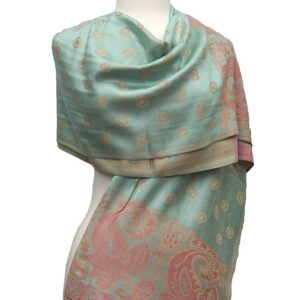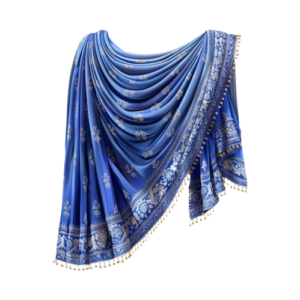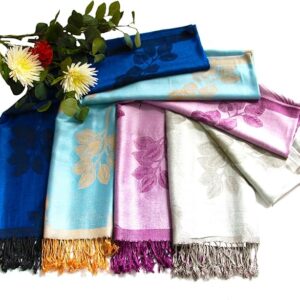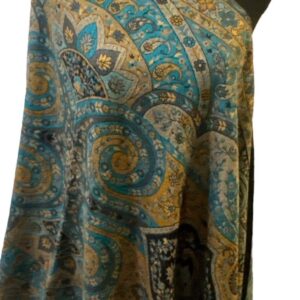When it comes to luxury fabrics, few can match the allure and elegance of pashmina. Known for its unparalleled softness and warmth, pashmina has captivated fashion enthusiasts and collectors for centuries. Yet, behind its exquisite charm lies a rich tapestry of history and craftsmanship that merits exploration. Let’s delve into the origins and meticulous artistry that define pashmina.
 The intricate patterns and designs found on pashminas often reflect local artistic traditions and cultural motifs. These designs not only enhance the beauty of the fabric but also tell stories of the region’s heritage and artistry.
The intricate patterns and designs found on pashminas often reflect local artistic traditions and cultural motifs. These designs not only enhance the beauty of the fabric but also tell stories of the region’s heritage and artistry.
The Origins Of Pashmina
The story of pashmina begins in the majestic Himalayas, where the rugged environment provides ideal conditions for the Pashmina goat, also known as the Changthangi goat. Native to regions in Nepal, Tibet, and northern India, these goats produce a rare and highly prized wool. The name “pashmina” comes from the Persian word “pashm,” which means wool. This unique wool is harvested from the soft undercoat of the Pashmina goat. During the harsh winter months, the goats develop a fine, insulating layer of wool that helps them survive the cold. Each goat produces only a small amount of this wool, making pashmina a rare and precious commodity. The wool is combed out during the spring molting season, ensuring that the process is both sustainable and gentle on the animals.The Craftsmanship Behind Pashmina
The transformation of raw pashmina wool into a finished shawl is a labor-intensive process that showcases exceptional craftsmanship. Here’s a closer look at the steps involved:1. Harvesting The Wool
The process starts with carefully combing the undercoat of the Pashmina goats. This wool is incredibly fine, with fibers measuring between 12 to 15 microns in diameter—much finer than human hair. The wool is collected in small quantities to ensure quality and is then cleaned and sorted to remove impurities.2. Spinning The Yarn
Once cleaned, the wool is spun into yarn. This process is often done by hand, requiring a skilled touch to ensure the fibers are spun evenly. Traditional spinning techniques preserve the softness and warmth of the wool, which is essential for the luxurious feel of the final product.3. Weaving The Fabric
The spun yarn is then woven into fabric using traditional looms. This stage is where the pashmina truly comes to life. Weavers use intricate techniques to create various patterns and designs, often inspired by nature, mythology, or local art. The weaving process can be time-consuming, with a single shawl taking weeks to complete.4. Dyeing And Finishing
After weaving, the pashmina fabric is dyed. Traditionally, natural dyes made from plants, minerals, and insects are used, resulting in rich, vibrant colors. The fabric is then washed and finished to enhance its softness and luster. This finishing process may include hand-embroidery or other embellishments, adding unique details to each piece.Cultural And Historical Significance
Pashminas are more than just luxury accessories; they hold significant cultural and historical value. Historically, they were worn by royalty and aristocrats as symbols of status and prestige. In the Himalayan region, pashminas have been a part of traditional dress for centuries, often featured in ceremonial attire. The intricate patterns and designs found on pashminas often reflect local artistic traditions and cultural motifs. These designs not only enhance the beauty of the fabric but also tell stories of the region’s heritage and artistry.
The intricate patterns and designs found on pashminas often reflect local artistic traditions and cultural motifs. These designs not only enhance the beauty of the fabric but also tell stories of the region’s heritage and artistry.
Modern-Day Pashmina
Today, pashmina continues to be celebrated for its elegance and versatility. It has transcended its traditional roots to become a global fashion staple, featured in collections from high-end designers and accessible to a wider audience. Modern pashminas come in various styles, including shawls, wraps, and scarves, and are often blended with other fibers to enhance durability and affordability. Despite its evolution, the essence of pashmina remains rooted in its traditional craftsmanship. Many contemporary artisans and brands are committed to preserving the artisanal methods that have been used for centuries. This dedication ensures that each pashmina retains its luxurious quality and heritage.Conclusion
Pashmina is more than just a fabric; it’s a testament to centuries of tradition, craftsmanship, and cultural significance. From its origins in the Himalayas to its place in global fashion, pashmina continues to captivate with its unparalleled softness and beauty. Understanding the origins and craftsmanship behind pashmina not only deepens our appreciation for this luxurious textile but also connects us to a rich heritage that transcends borders and time. Next time you wrap yourself in a pashmina, remember that you’re embracing not just a beautiful accessory but a piece of history woven with skill and passion.Explore Our Latest Collection
Uncover the essence of modern luxury and let your fashion journey begin with us.





